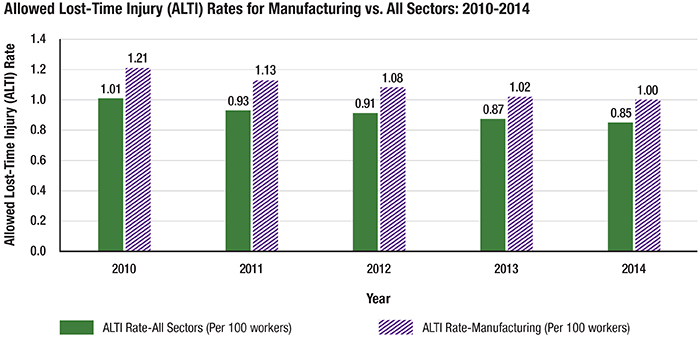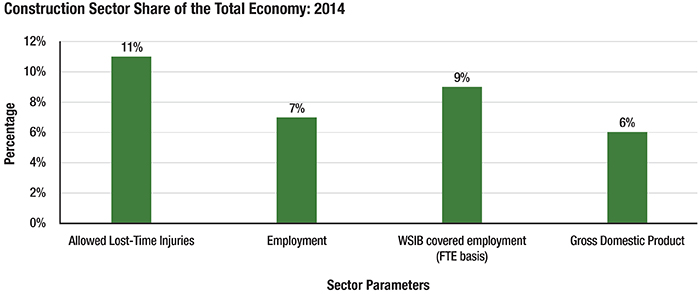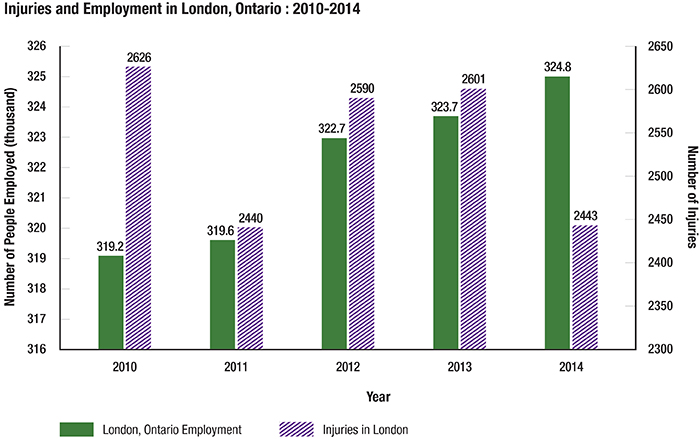Workplace Injury and Fatality Trends in Ontario
- Issued: July 2016
- Content last reviewed: July 2016
The profiles below show trends in workplace injuries and fatalities in Ontario from 2010 to 2014. These trends provide a critical lens through which to view the effectiveness of the occupational health and safety system in protecting our workers from injury.
For each of the five profiles below, examples are given based on hazard and data availability. For example, construction and manufacturing are two sectors with high workplace hazards so they are featured in two of the graphs below.
Publishing data online for public use on Ontario’s workplace fatalities and injuries allows citizens, businesses, researchers and others to help us solve problems that affect Ontarians every day. This is part of Ontario’s Open Government commitment to make government more open, transparent and accessible.
Traumatic Fatalities in Ontario
From 2010 to 2014, the distribution of traumatic fatalities across the province by age group was relatively stable. On average, 64% of the fatalities occurred in the 25-54 age group, 27% of fatalities occurred in the 55+ age group, and 8% occurred in the 15-24 age group. The only exception was 2013, when the 25-54 and 55+ age groups had proportionally more fatalities than the average of five years for these age groups.

| Year | Ages 15-24 | Ages 25-54 | Ages 55+ |
|---|---|---|---|
| 2010 | 6 | 57 | 22 |
| 2011 | 7 | 57 | 27 |
| 2012 | 9 | 52 | 18 |
| 2013 | 4 | 68 | 31 |
| 2014 | 9 | 50 | 21 |
Source: Ministry of Labour. Provincial Traumatic Fatalities.
Sector Trend: Allowed Lost-time Injury Rates for Manufacturing vs. All Sectors
The allowed lost-time injury (ALTI) rate in the manufacturing sector decreased steadily from 2010 to 2014. During that five year period, the injury rate in manufacturing was consistently higher than the injury rate for all sectors combined, and all sectors displayed a steady decrease in injury rate.

| Year | ALTI Rate for All Sectors (per 100 workers) | ALTI Rate for Manufacturing (per 100 workers) |
|---|---|---|
| 2010 | 1.01 | 1.21 |
| 2011 | 0.93 | 1.13 |
| 2012 | 0.91 | 1.08 |
| 2013 | 0.87 | 1.02 |
| 2014 | 0.85 | 1.00 |
NOTE: Data maturity for WSIB data: As at March 31st of the year following each injury year.
Sources:
- Workplace Safety and Insurance Board (WSIB).(2015). By the numbers, 2014. (PDF)
- Statistics Canada. No Date. Table 282-0008 - Labour force survey estimates (LFS), by North American Industry Classification System (NAICS), sex and age group, annual (persons unless otherwise noted), CANSIM (database).
Sector Share: Construction vs. All Sectors
In 2014, the construction sector had 11% of the total number of lost-time injuries for all sectors in Ontario. This is higher than its share of WSIB-covered employment (9%), overall employment (7%) and the province’s gross domestic product (6%).

| Sector Parameters | Share of Total in Ontario |
|---|---|
| Allowed Lost-Time Injuries | 11% |
| Employment | 7% |
| WSIB Covered Employment (FTE basis) | 9% |
| Gross Domestic Product | 6% |
NOTE: Data maturity for WSIB data: As at March 31st of the year following each injury year.
Sources:
- Workplace Safety and Insurance Board (WSIB).(2015). By the numbers, 2014. (PDF)
- Statistics Canada. No Date. Table 282-0008 - Labour force survey estimates (LFS), by North American Industry Classification System (NAICS), sex and age group, annual (persons unless otherwise noted), CANSIM (database).
- Statistics Canada. No Date. Table 379-0028 - Gross domestic product (GDP) at basic prices, by North American Industry Classification System (NAICS), provinces and territories, annual (percentage share), CANSIM (database).
Regional Profile: Injuries and Employment in London, Ontario
From 2010 to 2014 employment steadily increased in London, Ontario. Meanwhile, lost-time injuries fluctuated from one year to another with the highest number of injuries in 2010 and the lowest in 2011.

| Year | Number of People Employed (Thousands) | Number of Injuries |
|---|---|---|
| 2010 | 319 | 2626 |
| 2011 | 320 | 2440 |
| 2012 | 323 | 2590 |
| 2013 | 324 | 2601 |
| 2014 | 325 | 2443 |
NOTE: Data maturity for WSIB data: As at March 31st of the year following each injury year.
Sources:
- Workplace Safety and Insurance Board (WSIB). No Date. Enterprise Information Warehouse.
- Statistics Canada. No Date. Table 282-0125 - Labour force survey estimates (LFS), employment by economic region based on 2011 Census boundaries and North American Industry Classification System (NAICS), annual (persons), CANSIM (database).
Priority Profile: Falls From Heights by Sector
From 2010 to 2014, among all industry sectors in Ontario, construction experienced the most lost-time injuries due to falls from heights (26% of the total for all sectors). This was followed by retail (13% of the total), and transportation and warehousing (12% of the total). Falls from heights in construction appear to be increasing each year while falls from heights in the other two sectors decreased overall between 2010 and 2014.

| Year | Construction | Retail | Transportation and Warehousing |
|---|---|---|---|
| 2010 | 668 | 417 | 358 |
| 2011 | 704 | 407 | 382 |
| 2012 | 682 | 303 | 290 |
| 2013 | 739 | 359 | 312 |
| 2014 | 744 | 329 | 332 |
NOTE: Data maturity for WSIB data: As at March 31st of the year following each injury year.
Sources:
- Workplace Safety and Insurance Board (WSIB). No Date. Enterprise Information Warehouse.

#worksafeON | #workfairON